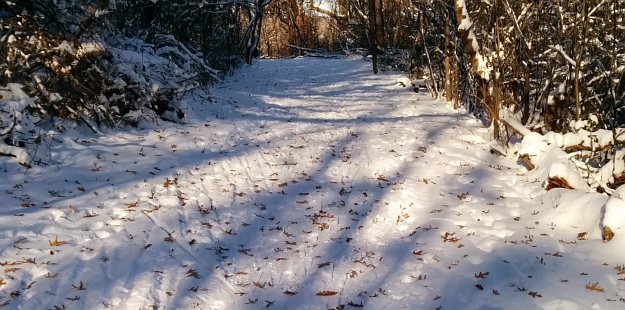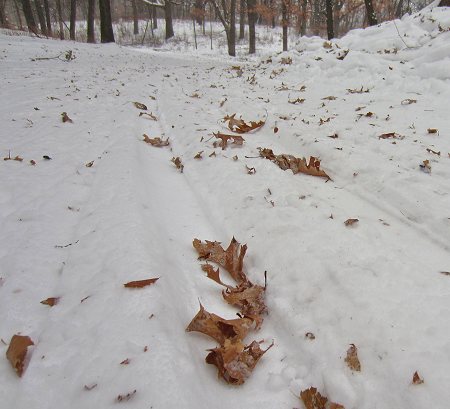What’s Up with All These Leaves?!

Much comment has been made of the leaves and organic detritus seen in the ski-ways this year. In fact, it seems like the volume of leaves and organic rubble we have seen since December on the trails is more commensurate with what we would normally see in late February. What’s up with all these leaves?
First, as alluded to above, we are used to seeing leaves on the trails, but usually in late February and March. Typically what we see are oak leaves. These are leaves that hang persistently in the trees through most of the winter before releasing. One might ask why they persist there. Members of the Fagaceae (beech) family are noted for having marcescent leaves, e.g., dead leaves that are retained on the tree through the winter. Upper Midwest native members of the Fagaceae family are the oaks and hornbeams. Those of you from parts east will be familiar with beech trees and their propensity for retaining leaves in a similar manner.
Normally if you look at oaks and hornbeams at this time of year you will notice that they are not completely covered with dead leaves. Young (juvenile) trees and the lower and inner most branches of larger trees retain dead leaves. Trees go through a change from a juvenile to mature phase as the tree ages. Interestingly, the newest, most recent growth on trees, the top and branch ends are the mature portions of the tree, while sections nearest the main trunk and the ground (referred to as the ‘cone of juvenility’) are juvenile. Thus, if you take a look, you will see dead leaves retained on older trees are retained in this ‘cone of juvenility’. On juvenile trees and in the juvenile regions of the tree the abscission layer (where the leaf attaches to the branch) does not die until late winter early spring on members of the Fagaceae family, thus the leaves are retained. Many hypotheses have been forwarded to explain this phenomenon, none of which reduce the nuisance these leaves create on the ski trail.
 The discerning amongst you have already realized the explanation above does not account for the increased volume of leaves we are seeing throughout this winter. To explain this, we need to invoke a second factor, the abnormal weather we have experience in the last year. You might remember the glorious late winter we had with skiing that extended into May? In the Twin Cities we had sub-freezing temperatures (31°) on April 19th and nearly sub-freezing temperatures on May 4th (34°). The plant world’s reaction to the long winter (late spring) was to remain dormant longer than usual. This resulted in something of a frame-shift for the growing season, such that trees were actively growing into the fall frost/freeze season. When the first freeze came this season, leaves in the ‘mature’ portions of the tree had not yet formed an abscission layer. The result was that many leaves froze in place on the oaks and hornbeams the way leaves in the ‘juvenile’ section typically do. The result being that every windy day this winter has precipitated a ‘rain’ of dead oak leaves on our trails.
The discerning amongst you have already realized the explanation above does not account for the increased volume of leaves we are seeing throughout this winter. To explain this, we need to invoke a second factor, the abnormal weather we have experience in the last year. You might remember the glorious late winter we had with skiing that extended into May? In the Twin Cities we had sub-freezing temperatures (31°) on April 19th and nearly sub-freezing temperatures on May 4th (34°). The plant world’s reaction to the long winter (late spring) was to remain dormant longer than usual. This resulted in something of a frame-shift for the growing season, such that trees were actively growing into the fall frost/freeze season. When the first freeze came this season, leaves in the ‘mature’ portions of the tree had not yet formed an abscission layer. The result was that many leaves froze in place on the oaks and hornbeams the way leaves in the ‘juvenile’ section typically do. The result being that every windy day this winter has precipitated a ‘rain’ of dead oak leaves on our trails.
The other detritus I have noticed in abundance on the trail, ash and box elder samaras (seeds), are not as neatly explained. Trees will often set larger seed crops in response to stress. Droughty summers in the last couple of years might be the environmental stress events that have resulted in the large seed crops we are seeing on the trails as well.
Stan Hokanson is a University of Minnesota professor specializing in Woody Landscape Plant Breeding & Genetics, as well as a master skier. In addition to biking and skiing, Hokanson has enjoyed watching his own son Steve grow into a top competitor at Junior Nationals and the State Meet. -- Ed.

